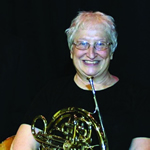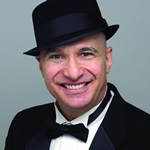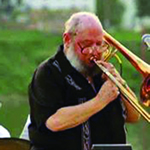Allegro
Preventing & Fixing Injuries as a Musician
Musicians put a lot of strain on their bodies. We asked our members for their stories about preventing and fixing injuries. Here's what you said...
Volume 116, No. 2February, 2016
Below are the stories of musicians who responded to our poll. We would like to hear from more of our members about this important topic. Please e-mail your stories to Allegro@Local802afm.org.
DISCLAIMER: The following stories are anecdotes from fellow musicians and are not a substitute for professional medical advice. What works for one person does not necessarily work for another. Use common sense and always consult a health professional before attempting any treatment.

Gregor Kitzsis
I think anyone who knows me knows the difference that Alexander Technique has made in my life. It is likely that I wouldn’t still be playing the violin or even walking normally without it. Proper use of your body is crucial to recovering from injury or just everyday life as a musician. Even if you do an hour of physical therapy every day it won’t help much if the other 23 hours a day you’re using your body wrong and stuck in bad habits you’re not aware of that are doing far more harm than you realize. Once I started learning Alexander Technique, all the chiropractor visits, massages and other stuff that wasn’t really helping started being much more effective. I will happily recommend my teacher to anyone who asks.
—Gregor Kitzis

Anne Slayden
I’m a horn player, female over 60, and I came up with a case of frozen shoulder on my left side. Not only did this severely limit my range of motion, but just holding the horn became quite painful. It wasn’t the weight of the horn, but the position of the arm. It hurt no matter what I did: put the horn on the knee, off the knee, supported by a strap, etc. After an X-ray and a type of MRI called an arthrogram, I was sent for physical therapy, which helped, as did home exercises. After 10 weeks, my range of motion was completely restored. Frozen shoulder affects mostly women over 60, and it will eventually go away by itself, but can take a year or so. But it turns out that my frozen shoulder had been masking an underlying case of tendonitis in my biceps, which still bothers me. It comes and goes. Rest is the prescription, but that’s impossible when you practice and play every day. Taking a Naproxen before a heavy rehearsal helps, and, thankfully, it hasn’t really slowed me down much. I’ve just added it to the list of aches and pains that come with aging, which sucks!
—Anne Slayden

Kyle Norris
In February 2007, I was on my way home after playing “Mamma Mia” on the Vegas strip. (I play keyboards.) A minivan attempted to cut across three lanes of traffic and I hit it broadside at 50 m.p.h. As my car spun around, I was then hit head-on by the car behind me. Amazingly, I walked away with no life-threatening injuries but I lost 80 percent of the strength in my right hand. Over the coming months, I underwent a great deal of physical therapy to regain both the usage and strength in the hand. The chiropractor, whom I credit with saving my hand and career, explained that although this injury would probably heal, I’d more than likely have to deal with it the rest of my life.
To help manage the injury, he gave me some exercises that help the strength and agility of the hand:
1. FINGER STRETCH: With your index and middle finger of the right hand, place them between the index and middle finger of your left hand. Open the fingers of your right hand while trying to close the fingers of the left hand. This resistance helps to build strength in the fingers. Repeat this exercise with the other fingers then switch hands and repeat the process.
2. SILLY PUTTY: Taking two fingers at a time, wrap silly putty around the fingers and then pull the fingers apart. Next, move the fingers around trying to stretch the putty in various directions. After a few times, move to a new combination of fingers.
3. RUBBER BAND: Repeat exercise #2 with a small rubber band. Then, with a large rubber band, use the thumb and pinky to stretch the rubber band, opening the hand to a wide position.
4. OPEN-CLOSE: With the hand fully flexed, slowly close it into a tight fist. Allow yourself to feel each knuckle bend throughout the process. Repeat the process gradually gaining speed each time until you’re able to make it one quick motion of an open hand to closed fist. It’s important to be conscious of each finger as it’s bending so that you’re developing an awareness and control of the muscles involved.
As far as recovery, I’m doing well. Weather change is always an issue for me physically, but in the past year I subbed on several Broadway productions and I’m currently touring with the show “If/Then,” starring Idina Menzel.
—Kyle C. Norris

Sariva Goetz
I have been a keyboard player on various Broadway shows since 1984. Keyboard setups have included a mapper pedal for many years now, allowing the player to step on a pedal to advance the patches on the keyboard. Sometimes I would have to step on this pedal 300 times every show. Multiply that by seven or eight shows a week over many years and you end up with a repetitive motion injury, even though the motion is very small. Over the years, my right hip deteriorated and became arthritic and I recently had to have the hip replaced. (The left hip is absolutely fine.) Thankfully, I am doing very well and still stepping on mapper pedals. I don’t see how this injury is completely preventable, especially if you might be susceptible to osteo-arthritis in any of your joints. However, there are ways to minimize it. First of all, it’s important to keep the mapper pedal as close as possible to the sustain pedal, to avoid extensive flexing of the hip joint. That’s not always possible if you are a sub and the regular player has the pedals taped down. It’s also important to not stomp on the pedal. A light tap is sufficient and will save a lot of wear and tear on all the joints in the right leg. Hope this helps!
—Sariva Goetz

Shell Zimet
Carrying your own sound equipment can not only be a drag but hazardous to your health. Here’s my story. I was setting up for a gig. I am usually very careful with my equipment: it’s expensive; and if you drop kick a powered speaker or your best mic, you have a problem. I always start out way ahead of schedule because I would rather cool my heels waiting to start instead of rushing in a heated frenzy to set up. I had a triple that week (it never rains; it only pours!), which consisted of Friday night in Manhattan, Saturday noon in Long Island, and Saturday night in Staten Island. On my last gig, I picked up my amp the wrong way and felt a twinge in my back. Something was wrong. I am a bandleader and vocalist so I was the front man. I had to hold on to the mic stand for dear life just to get though the first set. My back kept twinging and spazzing, but I kept going. Now I don’t recommend this, but on the first break I went straight too the bar and ordered a red wine…actually three or four! By the second set, my back was much better and I got through the night easily, with the help of a few glasses of wine at each break and on the bandstand. The host of the party did not seem to mind my drinking. (But as you know, drinking and playing can kill a gig.) The moral of the story is don’t rush for any reason, especially with heavy equipment. And lift with your legs!
—Shell Zimet

Bill Turner
Over the past 41 years that my band and I have been playing together, we’ve been pretty lucky with some of the rough-and-tumble bars we’ve had to appear in from time to time, with fights breaking out. One particular injury I endured happened at the end of one particular club gig. We had left the stage and one female fan rushed up to hug me. She was wearing decorative earrings and when she pulled away from me, I felt this wetness on my face. When I went to wipe it away, my hand was full of blood! The sharp edge of her earring had cut my face from my eyebrow right down my cheek, leaving a bleeding wound the entire length of the cut. It looked like I had been in a knife fight! Strangely enough, something similar happened years earlier. A fan ran up to hug me and bit me right on the chest. She bit me so hard it went right through my shirt! I stood there stunned. I had a huge bite mark that was bleeding!
—Bill Turner

Tony Salvatori
I am a right-handed bass trombonist. In 1972, I was playing “Pippin” on Broadway and teaching school in Kinnelon, New Jersey. Because of the continuous conducting at school, I developed bursitis in my right shoulder. By the end of a teaching day the pain was significant. Once in the pit playing the show, the pain gradually diminished. By the final curtain it was gone. My life lesson from this is that teaching music and performing music complement each other perfectly. They are the yin and yang of musical life. By September 1973, bursitis was no longer a factor.
—Tony Salvatori
–

Danny Young
A year ago, i was drumming on the road with Queen’s “We Will Rock You” tour. Being that this is a rock show and I try to sound and play like Roger Taylor in every way possible, I do a lot of hard and heavy hitting. Around the second week of tour I started to notice some discomfort in my right hand pointer finger. By the end of the week, it was so swollen and painful that I could no longer bend the finger. Not having a sub for the show, I had to continue playing and fight through the pain, which was continuously becoming more and more difficult. When I was finally able to get in to see a doctor, they diagnosed me with “trigger finger,” a condition where the tendon in the finger falls out of alignment, causing it to snap or lock, which results excruciating pain and swelling. The doctor’s advice to fix the injury was six to eight weeks off work and possibly surgery, depending on how severe the condition was. Not wanting to take time off or lose my show, I decided the best solution was to continue icing my finger as many times a day as I could, refrain from using the finger when I wasn’t drumming, and also reach out to my network of drummers for advice and options.
The first question I was asked by my friend Darcy was, “How hard are you hitting?” I knew I was playing hard, but didn’t really realize how hard until we talked about it in detail. Since I play the show using in-ear monitors while in a padded drum booth, it becomes pretty difficult to actually hear yourself play if the volume in your monitors isn’t high enough. My subconscious solution to not hearing myself was to play even harder, which was obviously the wrong solution. To solve this, I turned myself up in my personal mix and tweaked my EQ, allowing myself to back off from playing so hard without losing any of the sound or feel Roger is known for. I also became extremely aware of my finger positioning when I was playing to make sure I wasn’t changing my grip to compensate for pain, which could end up making the condition worse. I continued to ice my hand daily and even found rubber splints I could wear during the day to avoid overuse. Within a three-week period, the finger was back to 99 percent. This does not mean, however, that I’m out of the woods. I am still icing the finger if I start to feel any discomfort, and I continue to be hyper-aware of how loud and hard I am playing. I have started a pre-show stretching routine (including each individual finger) to make sure that everything is loose and ready for about three hours of hard-hitting rock. Fingers crossed that it won’t happen again, but I learned a very scary lesson about limits of the human body and the impact you can have on it.
—Danny Young
 About seven years ago, I sustained a foot injury that kept me from walking for over eight months. Due to the constant use of crutches, I woke up one day with four “trigger fingers” – two on each hand. To put it mildly, it was a total drag to wake up to what I thought would be a real life changer. The hand specialist in the orthopedic group was ready to go ahead with what I was told would be a minimally invasive procedure, but fortunately, my brother-in-law Ozvaldo Moscovich, a fabulous vet with offices in the East Village (and also a trumpet player and a big fan of the music) had a simple inexpensive cure that worked like a charm for me. I’m told it’s most effective in the early onset of trigger fingers. Here it is: go to a bicycle store and buy a pair of the squishiest handlebar grips they have (about $10?). When you go to sleep, put each one grip not in your palm, but as deep into the crooks of the finger knuckles as possible, so it is just your fingers that grab it when they clench. Put a sock over each hand so you don’t lose the grips in your sleep. As you doze off, gently give the grips a squeeze. When ever you’re half awake, another gentle squeeze. After two or three nights my trigger fingers disappeared and never came back. Again, I think this therapy is most effective if applied as soon as one first detects a trigger finger. If I understand correctly, the bicycle grip in the fingers gently stretches the backs of the fingers and enables the tendons to slide freely in their sheathes.
About seven years ago, I sustained a foot injury that kept me from walking for over eight months. Due to the constant use of crutches, I woke up one day with four “trigger fingers” – two on each hand. To put it mildly, it was a total drag to wake up to what I thought would be a real life changer. The hand specialist in the orthopedic group was ready to go ahead with what I was told would be a minimally invasive procedure, but fortunately, my brother-in-law Ozvaldo Moscovich, a fabulous vet with offices in the East Village (and also a trumpet player and a big fan of the music) had a simple inexpensive cure that worked like a charm for me. I’m told it’s most effective in the early onset of trigger fingers. Here it is: go to a bicycle store and buy a pair of the squishiest handlebar grips they have (about $10?). When you go to sleep, put each one grip not in your palm, but as deep into the crooks of the finger knuckles as possible, so it is just your fingers that grab it when they clench. Put a sock over each hand so you don’t lose the grips in your sleep. As you doze off, gently give the grips a squeeze. When ever you’re half awake, another gentle squeeze. After two or three nights my trigger fingers disappeared and never came back. Again, I think this therapy is most effective if applied as soon as one first detects a trigger finger. If I understand correctly, the bicycle grip in the fingers gently stretches the backs of the fingers and enables the tendons to slide freely in their sheathes.
—Jon Kass
Hearing loss is my only injury, caused over the years by: 1) Being too close to brass, winds or percussion, and 2) By nearby loudspeakers blasting the full band at excruciating volumes. Earplugs can obviously help a lot, but not totally. The only reason I have been able to continue playing is because of advances in hearing aid technology. My “in-the-canal” hearing aid (made by Siemens) has five different settings: normal conversation; telephone; loud environments like large crowds; quiet (for subway noise, etc.); and “music.” Each setting filters out specific parts of the harmonic spectrum. The music setting allows for the entire spectrum to be amplified, and is adjusted to each individual’s particular hearing loss. There is also a volume control. The settings and volume are controlled by a small remote, which can be placed in a pants pocket and activated from there.
–Local 802 freelancer
